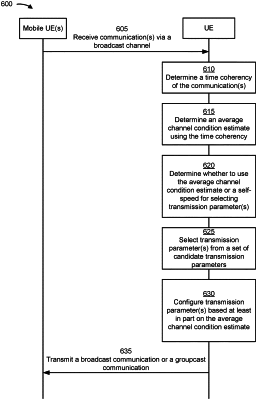| CPC H04W 72/30 (2023.01) [H04L 1/0003 (2013.01); H04W 4/40 (2018.02); H04W 8/24 (2013.01); H04W 72/02 (2013.01)] | 30 Claims |

|
1. A method of wireless communication performed by a user equipment (UE), comprising:
determining a time coherency associated with one or more communications, wherein the time coherency is based at least in part on a correlation between demodulation reference signals (DMRSs) associated with the one or more communications;
determining an average channel condition estimate for a broadcast channel based at least in part on the time coherency, wherein the broadcast channel is for broadcast communications or groupcast communications for multiple mobile UEs;
determining to use the average channel condition estimate for selecting one or more transmission parameters based at least in part on a number of communications, associated with a determination of the average channel condition estimate, received within a time window satisfying a threshold;
configuring the one or more transmission parameters based at least in part on the average channel condition estimate; and
transmitting a broadcast communication or a groupcast communication using the one or more transmission parameters.
|